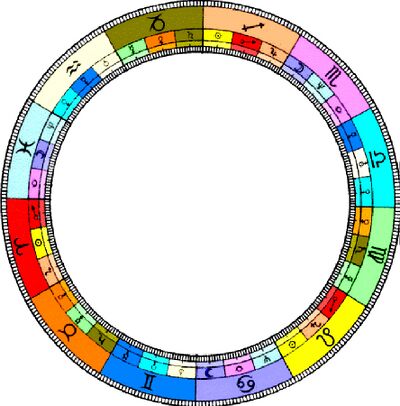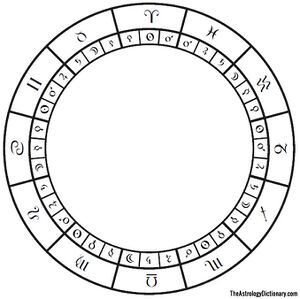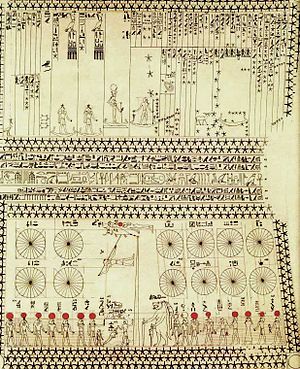Decan

Threefold division of each sign of the zodiac into 10 degree segments, sometimes called decanates or Faces. The first decan is from 0-9 degrees 59 minutes, the second 10-19 degrees 59 minutes and the third from 20-29 degrees 59 minutes.
History
In ancient Egypt the decan system originated as part of their calendar system. Initially the decans were stars that could be observed to rise at 10-day intervals. The Egyptian calendar had 360 days marked by decan stars rising at 10-day intervals, plus five inter-calculated days. Ancient Hellenistic astrologers eventually dropped the Fixed Star association, and simply divided each 30-degree Zodiac Sign into three equal segments.
Today there are different methods for determining the decan Ruler. In the so-called Triplicity system commonly used in Modern Astrology the first decan of any sign is the ruler of the whole sign. The ruler of the second decan is the ruler of the next sign in the same Element, and the third decan rules the sign after that in the same element. This gives rise to a systematic pattern of decan rulers.
Examples:
- First decan of Aries - ruler: Mars/ Aries
- Second decan of Aries - ruler: Sun/ Leo
- Third decan of Aries - ruler: Jupiter/ Sagittarius
- First decan of Taurus - ruler: Venus/ Taurus
- Second decan of Taurus - ruler: Mercury/ Virgo
- Third decan of Taurus - ruler: Saturn/ Capricorn
- First decan of Sagittarius - ruler: Jupiter/ Sagittarius
- Second decan of Sagittarius - ruler: Mars/ Aries
- Third decan of Sagittarius - ruler: Sun/ Leo
The decans give a bit more flavour or character to the zodiac signs. For example, a planet in the second decan of Sagittarius takes on a little of the assertive quality of Aries.
Chaldean Order Method of Decans
Yet the first, and apparently older method, is to assign one of the seven visible planets to each of the decans based on the Chaldean order of the planets. This method is frequently used in traditional western sources, from the 1st century through the 17th century CE.
So in traditional and Horary Astrology, the decans are often called "faces" and each 10-degree segment of a sign has a different planetary ruler (according to the Chaldean Order) .
The faces are considered minor essential dignities and are the least influential.
The assignments of this scheme are those of the seventeenth century horary astrologer William Lilly:

- Aries: Mars Sun Venus
- Taurus: Mercury Moon Saturn
- Gemini: Jupiter Mars Sun
- Cancer: Venus Mercury Moon
- Leo: Saturn Jupiter Mars
- Virgo: Sun Venus Mercury
- Libra: Moon Saturn Jupiter
- Scorpio: Mars Sun Venus
- Sagittarius: Mercury Moon Saturn
- Capricorn: Jupiter Mars Sun
- Aquarius: Venus Mercury Moon
- Pisces: Saturn Jupiter Mars
Triplicity Method of Decans[3]
The second method, which appears to have been developed somewhat later than the first, involves dividing each of the signs into thirds, and then making the assignments based on the other signs that are in the same Triplicity.
In this method the first 10 degrees of each sign belongs to the sign itself, while the second 10 degrees of the sign is associated with the next sign in zodiacal order that is of the same triplicity or element, and then the last 10 degrees of the sign is associated with the third sign in zodiacal order that is of the same triplicity.
For example, the first decan of Aries, from 0 to 10 degrees, belongs to Aries itself. The second 10 degrees of Aries, from 10 to 20 degrees, belongs to Leo, which is the next fire sign. The third 10 degrees of Aries, from 20 to 30 degrees, belongs to Sagittarius, which is the next fire sign after Leo.
This second method appears to have been used by Indian astrologers from a very early stage, although it was not until the 20th century that it became popular with western astrologers. In Modern Astrology the second method appears to have more widespread acceptance than the first.
See also

Weblinks
- For calculations at Astrodienst select Option Additional objects>Traditional astrology>show decans (Extended Chart Selection)
- Wikipedia: Decans
- The Egyptian Calendar and the Zodiac (Deborah Houlding 1996, 2003)
- The Decans in Astrology (Benjamin Dykes, 2004)
- Also contains three different versions/ lists of medieval "Images of the Decans" (“Faces”).
- The Role of Egypt in the Development of the Horoscope (Dorian Greenbaum/ Micah Ross, 2009; download from academia.edu)
- Denderah Illustrations of the Decans (tripod.com)
Bibliography
- Barton, Tamsyn, 1994. Ancient Astrology, Routledge
- Dunn, Barbara, 2009. Horary Astrology Re-examined, The Wessex Astrologer
- Lewis, James R. 2003. The Astrology Book: Encyclopedia of Heavenly Influences, Visble Ink Press
Notes and References
- ↑ Triplicity system
- ↑ Illustration from Chris Brennan's Astrological Dictionary
- ↑ Text mainly from Brennan's Astrological Dictionary
- ↑ Ancient Egyptian ceiling showing various decans, as well as the personified representations of stars and constellations